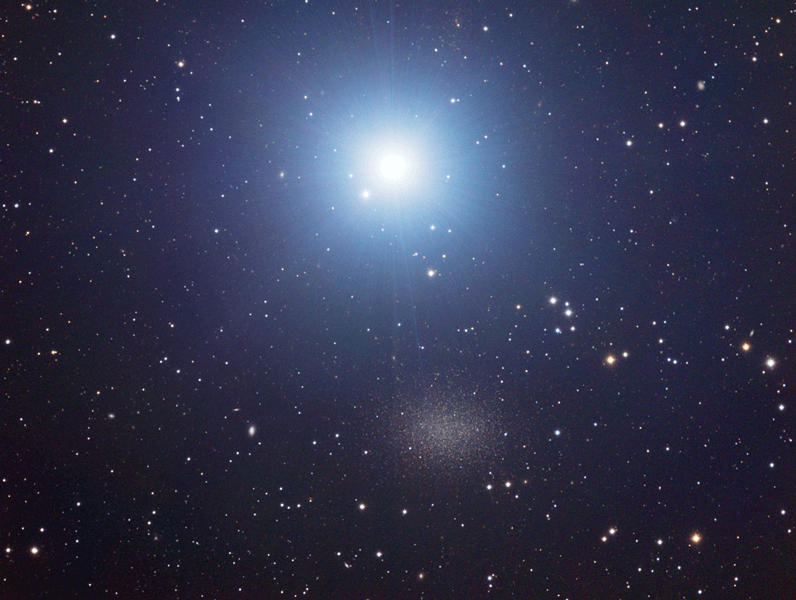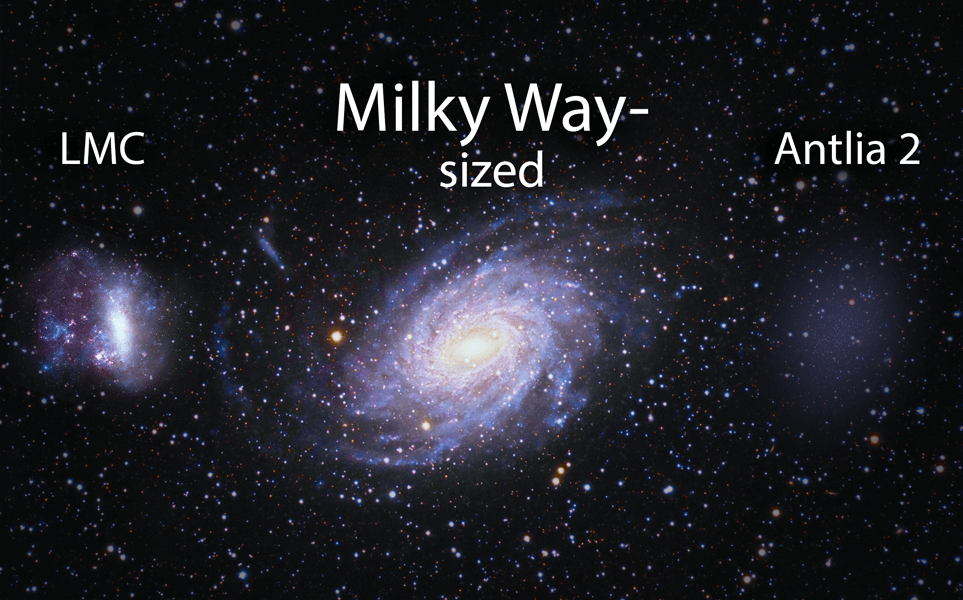In this big universe, it’s easy to feel small and insignificant, as if there’s nothing special about our planet, our star, our celestial neighborhood. After all, the sun is just one of hundreds of billions of stars in the Milky Way galaxy. What do we have to brag about?
Yet astronomers in the know have long realized that our galaxy is exceptional. By size alone, it’s “in the top percentile of all the galaxies that exist,” says Joss Bland-Hawthorn, an astronomer at the University of Sydney who helped compile the galaxy’s vital statistics for a 2016 article in the Annual Review of Astronomy and Astrophysics. He puts the Milky Way’s mass at a hefty 1.0 trillion to 1.6 trillion times that of the sun, outweighing the vast majority of its peers by a factor of 10 to more than a million and greatly outshining them as well.
This brilliance isn’t obvious, however. Look through a telescope and most of the galaxies you see are comparable in size, brightness and mass to ours. Well-known galaxies such as Andromeda and the Whirlpool are cases in point.
But that’s only because these prominent galaxies radiate about as much light as our own, which makes them easy to see, even across vast distances. That creates the impression that the Milky Way is average, when it’s actually a colossus. Judging galaxies by the rare giants is like evaluating people by the famous names you see on the front pages of newspapers. For people and galaxies alike, you’ll probably get a much more representative sample by checking out your nearest neighbors.

Far beyond brilliant Regulus (top), the brightest star in the constellation Leo, lurks the ghostly galaxy Leo I (bottom), a Milky Way satellite 830,000 light-years from Earth. Astronomers first spotted the elusive galaxy in 1950.
CREDIT: CHRIS COOK / COOKPHOTO.COM
New galaxies nearby
To see how the Milky Way fits into the broad spectrum of galaxies, astronomers must survey all the types of galaxies that exist, from bright to dim. That’s most easily accomplished by looking closest to our own, where we can detect even the dimmest and most feeble of galaxies. In recent years, that search has yielded an explosion in the number of known galaxies nearby.
A clearer picture of our galactic neighbors began to emerge back in 1938, when Harvard astronomer Harlow Shapley inadvertently took the first step toward demolishing the notion that the Milky Way is an average galaxy. While looking at a photographic plate of the obscure southern constellation Sculptor, he noticed a faint smudge. Just a fingerprint or some other defect, he thought — until a second photographic plate of the same constellation showed the same smudge. Soon after, he found another smudge in the neighboring constellation of Fornax.
The smudges in Sculptor and Fornax were galaxies of a new type: ghostly ones that astronomers now call dwarf spheroidals. Dim and diffuse, with their stars spread out from one another, they don’t exactly beckon through a telescope. Both are among our closest galactic neighbors — so close, in fact, that they orbit the Milky Way, just as moons orbit a planet, making them satellite galaxies of our own. The Sculptor Dwarf Spheroidal is 280,000 light-years from Earth, and the Fornax Dwarf Spheroidal is 455,000 light-years away. And they are dim. Whereas the Milky Way emits 30 billion times as much light as the sun, Sculptor produces just 1.8 million solar luminosities and Fornax just 19 million.
The number of known galaxies orbiting our own has soared. Barely a century ago, astronomers knew of only two: the Large Magellanic Cloud and the Small Magellanic Cloud. Later, however, observers spotted much dimmer satellite galaxies, starting with Sculptor and Fornax in 1938. Since the beginning of the twenty-first century, the number of known Milky Way satellite galaxies has quintupled. This diagram does not include recently discovered Antlia 2.
In the decades following Shapley’s discovery, astronomers spotted additional dwarf spheroidal galaxies revolving around the Milky Way. With improved technology, the new finds were more and more wispy and less and less conspicuous. A dwarf spheroidal flagged in 1990 in the constellation Sextans was such a galactic underdog it took a computer to spot it. Without one, “there’s no way Sextans would have been found,” Mike Irwin, an astronomer at the University of Cambridge, has said. “It’s virtually impossible to find by eye.” The computer had detected a subtle concentration of stars on a photographic plate. All travel at the same velocity and appear at the same distance, indicating they belong to the same dim galaxy, 310,000 light-years from Earth.
The Sextans Dwarf Spheroidal was the 10th galaxy found to orbit the Milky Way. Thus, by 1990, our galaxy was the hub of an empire encompassing 11 known galaxies: itself, eight dwarf spheroidals, and two bigger and brighter satellite galaxies, the Large and Small Magellanic Clouds.
The rise of the ultra-faint galaxies
In 2005, the number of known Milky Way satellites began to soar after searches of large areas of the sky uncovered a new type of galaxy, what astronomers call the ultra-faint dwarfs, even smaller and dimmer than dwarf spheroidals. Adding in the ultra-faint systems boosts the number of all known Milky Way satellite galaxies to more than 50, writes Josh Simon, an astronomer at the Carnegie Observatories in Pasadena, California, in the 2019 Annual Review of Astronomy and Astrophysics. Most are ultra-faint dwarfs; all are dimmer than the Milky Way. And last year, Simon made a surprising discovery suggesting that plenty more satellite galaxies await detection.
Watch the Milky Way’s satellite galaxies pop into view over time, their appearance marking the year of their discovery, in this video created by Marcel S. Pawlowski, an astronomer at the Leibniz Institute for Astrophysics in Potsdam, Germany. The scene starts with the Milky Way’s disk (the small white oval at center) attended only by its two most luminous satellites, the Large Magellanic Cloud (blue dot labeled LMC) and the Small Magellanic Cloud (blue dot SMC), then slowly adds what are called the classical dwarf spheroidals (other blue dots) that emerged into view from 1938 to 1994. After a fallow period, the video explodes with the plethora of newer discoveries (red dots) and finally with the very latest finds (green dots), most too faint to be detected until recently.
CREDIT: MARCEL S. PAWLOWSKI / MARCELPAWLOWSKI.COM
Simon drew that conclusion after mapping the positions of ultra-faint galaxies in their orbits around the Milky Way. Just as every planet revolves around the sun in an elliptical orbit, so every Milky Way satellite revolves around the galactic center in an elliptical orbit. And just as gravity causes the planets to move fastest when nearest the sun, so satellite galaxies speed up when nearest the Milky Way and slow down at their farthest. As a result, at any given time most satellite galaxies should be lingering around the farthest points in their orbits.
But Simon found something different — most of the 17 ultra-faint dwarf satellites he analyzed were close to their near points instead. The most natural explanation, he says, is that scientists are seeing just a small fraction of the much larger number of ultra-faint dwarf galaxies that are out there, most of which are at their orbital far points. But because they are farther away and harder to see, these additional galaxies have so far eluded discovery, Simon reasons.
“For the next 10 years or so, I think the number of [satellite] galaxies will increase pretty dramatically,” says Vasily Belokurov, an astronomer at the University of Cambridge whose team has turned up many of the new galaxies. He suspects that the Milky Way has a total of roughly 200; even the most conservative estimates put the number at 100. And that makes the Milky Way even more of a galactic standout, in the top 1 percent, says Simon: Fully 99 percent of all galaxies would be smaller, fainter and less massive — giving our galactic home an A-plus from any cosmic teacher who grades the galaxies. If the total satellite population is as high as 200, we’d be in the top 0.5 percent.

Shown to true relative scale: the Large Magellanic Cloud, the Milky Way’s brightest satellite (left); a Milky Way twin named NGC 6744 in the constellation Pavo (center); and an illustration of Antlia 2 (right), a large but dim satellite galaxy that turned up only in 2018.
CREDIT: COMPOSITE CREATED BY V. BELOKUROV, BASED ON THE IMAGES BY MARCUS AND GAIL DAVIES AND ROBERT GENDLER
In short, we live in a galaxy that is far bigger, brighter and more massive than most other galaxies in the universe. And in all likelihood, so do most other life forms in the universe, if such exist. That’s because the small galaxies that throng the cosmos possess so few stars; our own galaxy has many more stars than all the galaxies revolving around it put together. So, in terms of pure numbers, if every star has exactly one planet that is exactly like Earth and teeming with life, it’s likely that most living beings in the universe reside in a galaxy that’s far above average.
So the next time you’re speeding through intergalactic space in your brand new galaxyship — mere starships are so twenty-third century — you can brag to any aliens you meet beyond the Milky Way that you hail from a gargantuan galaxy. But chances are, so can they.




